1999
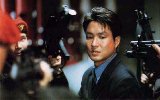



From left: "Shiri", "Nowhere to Hide", "Harmonium in My Memory", "Happy End"
The year 1999 marked a turning point the Korean film industry, with a marked jump in the box-office performance of local movies and an increased confidence among people involved in the film industry. The first sign of a change occurred when Kang Je-gyu's action film Shiri became an instant box-office smash, breaking the former box-office record held by Titanic. Korea had never before attempted a genre film on such a scale, and the result was greater than anyone's expectations.
Had it only been Shiri, however, the Korean boom would never have happened. Other major hits such as Attack the Gas Station and Tell Me Something drew large crowds of viewers and made Koreans strongly enthusiastic about local movies for the first time in decades. Local film companies sensed this and became more willing to take risks, unveiling plans for big-budget genre films that had never been made in Korea. Money, primarily from venture capital, began to surge into the industry.
Other changes were taking place. For the first time, private international sales companies like Mirovision and Cineclick Asia appeared with the goal of selling Korean movies abroad. By attending foreign festivals and markets, these companies were able to sell a range of Korean films to other territories (primarily Asia), setting the stage for the international 'discovery' of Korean cinema. More Korean international sales companies would quickly follow in their path.
On the artistic side, Lee Myung-Se's Nowhere to Hide created a powerful impression with its visuals, and enjoyed a successful run on the festival circuit. Films by debut directors Jung Ji-woo (Happy End) and Kim Tae-yong/Min Kyu-dong (Memento Mori) also drew strong praise from critics.
Reviewed below: Shiri (Feb 13) -- Love Wind Love Song (Feb 13) -- Harmonium in My Memory (Mar 27) -- The Picnic (n/r) -- The Spy (May 15) -- The Ring Virus (Jun 12) -- Yellow Hair (Jun 26) -- Fly Low (Jul 3) -- Yonggary (Jul 17) -- Nowhere to Hide (Jul 31) -- Calla (Sep 18) -- Attack the Gas Station (Oct 2) -- Tell Me Something (Nov 13) -- Happy End (Dec 11) -- Memento Mori (Dec 24).
| Korean Films | Seoul Admissions | Release Date | Weeks | |
|---|---|---|---|---|
| 1 | Shiri | 2,448,399** | Feb 13 | 17 |
| 2 | Attack the Gas Station | 960,000 | Oct 2 | 11 |
| 3 | Tell Me Something | 730,000 | Nov 13 | 6 |
| 4 | Nowhere to Hide | 687,000 | Jul 31 | 9 |
| 5 | Happy End | 557,294 | Dec 11 | 6 |
| 6 | Yonggary | 500,000 | Jul 17 | 6 |
| 7 | Ghost in Love | 420,000 | Aug 14 | 5 |
| 8 | Phantom the Submarine | 365,000 | Jul 31 | 7 |
| 9 | The Ring Virus | 332,354 | Jun 12 | 7 |
| 10 | City of the Rising Sun | 329,778 | Jan 1 | 5 |
| All Films | Seoul Admissions | Release Date | Weeks | |
|---|---|---|---|---|
| 1 | Shiri (Korea) | 2,448,399** | Feb 13 | 17 |
| 2 | The Mummy (US) | 1,260,000 | Jul 10 | 8 |
| 3 | Attack the Gas Station (Korea) | 960,000 | Oct 2 | 11 |
| 4 | The Matrix (US) | 910,000 | May 15 | 9 |
| 5 | Sixth Sense (US) | 879,000 | Sep 18 | 9 |
| 6 | Tarzan (US) | 820,000 | Jul 17 | 7 |
| 7 | Star Wars: Episode One (US) | 811,000 | Jun 26 | 7 |
| 8 | Tell Me Something (Korea) | 730,000 | Nov 13 | 6 |
| 9 | Nowhere to Hide (Korea) | 687,000 | Jul 31 | 9 |
| 10 | Love Letter (Japan) | 645,615 | Nov 20 | 8 |
* Includes tickets sold in 2000.
** Shiri drew an estimated 6.2 million admissions nationwide.
Market share: Korean 39.7%, Imports 60.3% (nationwide)
Films released: Korean 49, Imported 297
Total attendance: 54.7m admissions
Number of screens: 588 (nationwide)
Exchange rate (1999): 1176 won/US dollar
Average ticket price: 5,230 won (=US$4.45)
Exports to other countries: US$5,969,219
Average budget: 1.4bn won + 0.5bn p&a costs
Source: Korean Film Council (KOFIC).
Short Reviews
These are some reviews of the features released in 1999 that have generated the most discussion and interest among film critics and/or the general public. They are listed in the order of their release.
When Shiri was first released, its producers had reason to hope that the film would draw well at the box office. It starred several well-known actors, including perennial favorite Han Suk-gyu (Christmas in August, The Contact, No. 3, Green Fish, The Ginkgo Bed) and veteran Choi Min-shik (The Quiet Family, No. 3, Our Twisted Hero). Its director, Kang Je-gyu (aka Jacky Kang) had found considerable success with his debut feature, The Ginkgo Bed. It also featured highly-advanced special effects, the likes of which have never been seen in Korean films. The story, an espionage thriller about an terrorist plot hatched by North Korean agents, was likely to draw interest in a country much concerned about its neighbor to the north. However, no amount of optimism could have predicted just how successful this film would prove to be.
 Within three weeks of its release, it had attracted more than one million viewers in Seoul, passing Im Kwon Taek's Sopyonje to become the highest-drawing Korean film in history. Only five weeks later, it would pass Titanic and become the first film ever to draw two million viewers in the capital. It would eventually attract close to two and a half million viewers in Seoul alone.
Within three weeks of its release, it had attracted more than one million viewers in Seoul, passing Im Kwon Taek's Sopyonje to become the highest-drawing Korean film in history. Only five weeks later, it would pass Titanic and become the first film ever to draw two million viewers in the capital. It would eventually attract close to two and a half million viewers in Seoul alone.
Shiri (pronounced "Shee-ree", alternate spelling: "Swiri") has drawn praise from a wide variety of sources. Members of the Korean national intelligence agency gave it a standing ovation for its detailed and accurate depiction of espionage operations. It has already received honors for best picture and best actor (Choi Min-shik, for his portrayal of a North Korean agent) at domestic awards ceremonies. The making of the film has even been analyzed and offered up as a model for Korean businesses hoping to succeed in the new century.
Indeed, the film is tightly constructed, and it many ways it rivals action movies from Hong Kong and Hollywood. Viewers have debated over the film's genre, with some describing it as a Hollywood-style action film while others term it a melodrama. We can safely say that it's both, offering both the special effects expected from Hollywood studios and the conventions of melodrama that have attracted Korean movie-goers for decades.
For those wondering about the title of the film, "Shiri" is the name of a small freshwater fish which can only be found in the central part of the Korean peninsula (i.e. the DMZ). It is also the code name taken by a North Korean spy who steals the closely-guarded CTX liquid bomb, which she then plans to detonate at an inter-Korean soccer match.
In all, this film offers an intricate plot complemented by great acting and smooth direction. It was made for $5 million, which, although quite high for a Korean feature, makes one wonder why Hollywood studios spend so much more, only to produce an inferior product. (Darcy Paquet)
As a white guy from the United States writing about South Korean cinema, I am always cautious of making sure I am not depicting Koreans and Korean cultures as something exotic when writing about their films. I take pains to address the unfortunate Eurocentric Mis-Education of Adam Hartzell that is a result of growing up throughout the successful and unsuccessful battles of the cultural wars within my particular hamlets of the United States. It appears that Jo Myeong-ju is aware of this tendency within some of her fellow Koreans as well, that is, Korea's own special variation of exoticism towards the multicultural spectrum throughout South Korea, because such is demonstrated in her screenplay for Love Wind, Love Song. The debut feature for director Park Dae-young, the film follows a time in the life of Young-seo (Ko So-young -- Beat, A Day), a Cheju Island native who hosts bus tours of the island for visitors. Her banter with the tourists begins by stepping into Cheju dialect, and her use of humor often involves jokingly, yet not so jokingly, asking the tourists to be matchmakers for her with their sons back home. Her mother and a local cop repeatedly warn Young-seo about mainland men, claiming those relationships will never work out, although each has their own personal reasons for emphasizing a pessimistic perspective on such intra-national, cross-cultural relationships. Outside of her tours, Young-seo stumbles upon love at first sight with a mainlander from Seoul named Tae-hee (Jang Dong-gun -- Friend, Tae-gu-ki) who is traveling alone, a fact perfectly in sync with his present life perspective which limits his options in his career as well as for romance.
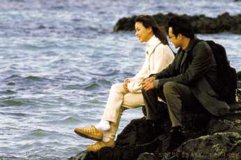 As a popular vacation spot for South Koreans, Cheju Island natives are apparently just as at risk of being exotically typecasted as Koreans might be by Westerners. The film plays around with the dialect differences while countering displays of the touristy spots with equal de-romanticizing of these "exotic" locales. Tae-hee encourages Young-seo's offer as his personal tour guide, but in his refusal to get too close, he also refuses to use her as an image of some place of mystery, desperately wanting the intimate, human connection he feels his fate won't allow him to have. The most striking incident of de-exoticism involves the revisiting of a Red Cap ad for Cheju Island tours in the Seoul airport which fills up the screen, making Yeong-seo look insignificant in opposition. The subtitles translate this sign as declaring Cheju Island, "The Island of Love and Fantasy!" When Young-seo stops in front of it, you expect the girlfriend to return later to throw a brick at it -- as is actually done in Christmas In August and When I Turned Nine - to smash through the luminescent lie.
As a popular vacation spot for South Koreans, Cheju Island natives are apparently just as at risk of being exotically typecasted as Koreans might be by Westerners. The film plays around with the dialect differences while countering displays of the touristy spots with equal de-romanticizing of these "exotic" locales. Tae-hee encourages Young-seo's offer as his personal tour guide, but in his refusal to get too close, he also refuses to use her as an image of some place of mystery, desperately wanting the intimate, human connection he feels his fate won't allow him to have. The most striking incident of de-exoticism involves the revisiting of a Red Cap ad for Cheju Island tours in the Seoul airport which fills up the screen, making Yeong-seo look insignificant in opposition. The subtitles translate this sign as declaring Cheju Island, "The Island of Love and Fantasy!" When Young-seo stops in front of it, you expect the girlfriend to return later to throw a brick at it -- as is actually done in Christmas In August and When I Turned Nine - to smash through the luminescent lie.
Although interesting in what it says about mainland South Korea's perceptions of Cheju Island natives, I found myself unimpressed with this film when simply considering its general entertainment value. Considering its willingness to investigate a topic worthy of further exploration, I'm hoping that poor subtitles have a lot to do with my response to the film, because the film is too often boring and, well, annoyingly cheesy. Commendably, Jang and Ko do what they can with the script they've been dealt, but the film drags too much for me. This is not a patient, contemplative film like Park Ki-young's Camel(s), but a weak portrait of stars-not-crossing lovers. Although Young-seo's friend's cliched, romance guidance is eventually critiqued as just that, cliched, the subtitled dialogue presents a weakly laid out drama. And even if the poor subtitles excuse is valid, the scenes at the English language school are just too heavy-handed in their placement within the plot to provide depth to the film, and the weak series of missed connections just had me wishing the film would end as quick as Park's next feature, the differently poor, but thankfully short, Just Do It!, so I could get on with more fulfilling films. Park apparently didn't learn as much as he could have from assisting Kim Hong-joon on Jungle Story, because this film desperately wanted to be a contender as something uniquely South Korean. But the topic, unfortunately, wasn't utilized for the full entertainment and expositive value it could have provided. (Adam Hartzell)
The setting for this film is 1962, when a young teacher from Seoul takes his first job at a village school in Kangwon Province. When he arrives, his students present him with a number of challenges: many of them are poor, and cannot write properly; classtime is interrupted by fighting or visits from relatives. Nonetheless the students seem to enjoy his caring, idealistic approach, even if they don't always do what he tells them to.
 At this time one of his older students begins to fall in love with him. She makes use of her daily journal assignments to comment on his teaching and ask him probing, curious questions. When she notices a romance developing between him and another teacher, she does her best to discredit her rival by harping on her age and stealing her shoes in class.
At this time one of his older students begins to fall in love with him. She makes use of her daily journal assignments to comment on his teaching and ask him probing, curious questions. When she notices a romance developing between him and another teacher, she does her best to discredit her rival by harping on her age and stealing her shoes in class.
Director Lee Young-jae takes a lighthearted approach to this film, as evidenced by his casual jokes and the stereotyped portrayals of the older teachers at the school. This humor helps to put the ideals of the teachers and the passions of first love into perspective, without detracting from the underlying seriousness behind them. Jeon Do-yeon (The Contact, A Promise) is wonderful here once again as the 17-year old schoolgirl who battles with her timidity to make passes at her teacher. The teacher is played by Lee Byung-heon, a popular TV, stage and film actor. Lee Mi-yeon (Whispering Corridors, No. 3) acts as Jeon's rival, an idealistic young teacher who arrives from Seoul to teach at the same school.
As a teacher I've been subjected to a great many films that mythologize teaching and spin touching but ingenuine tales of success in the classroom. What I like best about this film is its lack of a triumphant breakthrough. Its honesty and light humor make us believe in the characters and care about what happens to them. By the time we reach the end of the film, it hits us with more power than we ever expected. (Darcy Paquet)
Many critics contend that the strongest and most creative work being produced in Korea today is in short film. At present, Korea's short film industry is enjoying a renaissance, thanks to expanding sources of funding, increased public interest, accolades from abroad, and a series of remarkable films shot by young, talented directors. In 1998, "Skate" by Cho Eun-ryong became the first short film from Korea to compete in the Cannes Film Festival. Also that year, Kim Jin-han took home the top prize from France's Clermont-Ferran Short Film Festival for "Crack of the Halo," a dreamlike piece about two children locked in a small room by their parents.
 This year Korea had an unprecedented four films invited to the Cannes Film Festival; three in the short film competition section: "The Picnic" by Song Il-gon, "Simultaneity" by Kim Song-sook, and "Eternity" by Kim Dae-hyun; and one in the Cinefoundation section, Lee In-kyun's "The Execution". Ultimately "The Picnic" would take home the Jury Prize in the short film category, marking Korea's first ever award from Cannes.
This year Korea had an unprecedented four films invited to the Cannes Film Festival; three in the short film competition section: "The Picnic" by Song Il-gon, "Simultaneity" by Kim Song-sook, and "Eternity" by Kim Dae-hyun; and one in the Cinefoundation section, Lee In-kyun's "The Execution". Ultimately "The Picnic" would take home the Jury Prize in the short film category, marking Korea's first ever award from Cannes.
"The Picnic," fourteen minutes long, opens with a man driving along the seashore with his wife and three-year old son. They arrive at a secluded grove, and the son pleads with his parents to take him to the beach. Next, however, we see the man mix a dose of sleeping medicine into his son's milk, and gradually we become aware that their picnic is no ordinary outing.
Song Il-gon, 28 years old, is currently studying film in Poland. Two of his previous films have competed at international short film festivals and have been released in Korea at a theater which devotes two screenings a day to short film. "Liver and Potato" (1998), based loosely on the story of Cain and Abel, won awards at film festivals in Poland, Italy, and Greece. "The Dream of the Clowns" (1998) is an impressionistic, beautifully photographed piece shot in a Polish circus.
"The Picnic," together with the other three films invited to Cannes this year, will be given a general release in Korean theaters in late July. (Darcy Paquet)
Late at night, a North Korean spy washes onto the shores of Kangwon Province unseen and prepares for his initial assignment: to find and steal the genetically-engineered "Superpig", an animal developed by a team of South Korean biologists. Within hours, however, he falls victim to a group of thieves who steal his belongings and leave him stranded. As time goes on he realizes that his training did nothing to prepare him for the complex life he leads in the South.
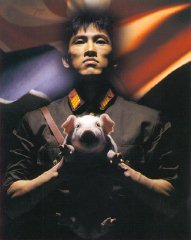 This is the second film this year to portray North Koreans in a sympathetic light; the last director to try this did so in the 1960s, and was subsequently jailed for his efforts. The Spy, a comedy, utilizes laughter to humanize those from the North.
This is the second film this year to portray North Koreans in a sympathetic light; the last director to try this did so in the 1960s, and was subsequently jailed for his efforts. The Spy, a comedy, utilizes laughter to humanize those from the North.
Perhaps the most memorable aspect of this film will be the bewildered, lost gaze of its protagonist, played by Yoo Oh-Sung (Beat). Whether checking out money at a bank or simply crossing a street during rush hour, we see how out of place he feels, and how much he misses his home. Even his successes, when they come, feel somewhat alien in a country where he just doesn't fit.
Director and screenwriter Jang Jin enjoyed a successful career in theatre before moving into the film industry with The Happenings in 1998, which was shown to favorable reviews at the 3rd Pusan Film Festival. Both of Jang's films to date have been praised for his creative, intricate screenplays that link absurd bursts of humor with slower, more reflective scenes.
Jang's work remains greatly influenced by the theatre, but in The Spy, perhaps responding to criticism that his first film was "too theatrical", he also experiments with the purely cinematic features of the medium, such as in a creative use of sound in the opening scene, and a quieter moment in the middle where the frame gradually contracts until the screen is left mostly black. More than anything else, however, Jang's movies are appreciated for their humor -- a mix of the subtle, the wacky and the outrageous. (Darcy Paquet)
In the past two years especially, the Korean film industry has embraced the genre of horror, producing such interesting and creative titles as Whispering Corridors and The Quiet Family. Of the films to be born of this trend, however, The Ring Virus is likely the scariest.
 This film, a Japanese-Korean coproduction, is an official remake of the popular 1998 movie from Japan titled Ring, based on the bestselling novel by Japanese author Suzuki Koji. The Ring Virus opens with a journalist named Sun-ju investigating the sudden death of her cousin, who was one in a string of similar deaths around the city. After reading a message on her cousin's pager, Sun-ju finds a videotape filled with strange images and a chilling message: "Exactly one week after you watch this videotape, you will die."
This film, a Japanese-Korean coproduction, is an official remake of the popular 1998 movie from Japan titled Ring, based on the bestselling novel by Japanese author Suzuki Koji. The Ring Virus opens with a journalist named Sun-ju investigating the sudden death of her cousin, who was one in a string of similar deaths around the city. After reading a message on her cousin's pager, Sun-ju finds a videotape filled with strange images and a chilling message: "Exactly one week after you watch this videotape, you will die."
With the help of a beleaguered neurologist who performed autopsies on the victims and pronounced their deaths to be supernatural, Sun-ju learns that the videotape was made by a psychic named Un-seo who had years earlier been thrown into a well. Sun-ju now stakes her survival on somehow contacting this young woman from the past.
Director Kim Dong-bin creates a chilling, coldly aesthetic film that integrates supernatural imagery and the equipment of contemporary media. Kim heightens the tension produced by the storyline with a palette of bluish dark colors and an odd, pulsating soundtrack. Shin Eun-kyung, who also starred in Im Kwon-taek's 1997 feature Ch'ang (or "Downfall"), gives an impressive performance as the young reporter who must overcome her fears to discover the source of this sequence of deaths.
The Ring Virus lacks the earthy mysticism of the Japanese original, but it does provide a more detailed rendering of the plot and some interesting variations on the story. Fans of the original should have an interesting time comparing the two films. (Darcy Paquet)
Under normal circumstances, when students do a direct translation from Korean to English and describe someone as having yellow hair, I would correct them by suggesting the more appropriate term of blond. But in the case of the characters of Kim Yu-min's erotic thriller, that phrase is perfectly suitable, The hideous yellow of Yu-na (Lee Jae-eun)'s tresses is matched in brightness only by the equally garish orange adorning the dyed head of her friend Sang-hee (Kim Gi-yeon).
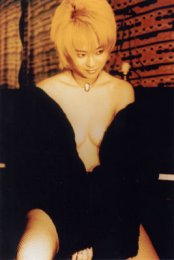 The excess of color is a physical manifestation of the freedom that defines the girls' lives while setting them firmly apart from a more conservative society. In this way, the pair flaunt the fact that they are outsiders refusing to conform, and they remain true to their independent spirits. However, their unrestrained disregard for social norms and mores is what ultimately leads to trouble.
The excess of color is a physical manifestation of the freedom that defines the girls' lives while setting them firmly apart from a more conservative society. In this way, the pair flaunt the fact that they are outsiders refusing to conform, and they remain true to their independent spirits. However, their unrestrained disregard for social norms and mores is what ultimately leads to trouble.
Their troubles start during one of their trips from their converted greenhouse home to a nightclub in town where they encounter Yeong-gyu (Kim Hyeong-cheol) for the first time. Clearly damaged goods, Yeong-gyu staggers drunkenly around the dance floor desperately trying to dance with any group, men or women, that will accept him but he meets with rejection on all fronts. This captures the interest of Yu-na who sympathizes with him as a fellow outsider because of his exclusion. There is another reason that she chooses to bring him home with her, though. His evident loneliness combined with his appearance that marks him as a recent businessman-turned-vagrant marks him as being a disposable lover in the most literal sense. She and her partner Sang-hee have casually 'disposed' of at least one other lover in the past. However, what she does not count on is the feeling of attraction growing within her for this pathetic man or the possessiveness that gradually develops.
These possessive feelings begin to take root after Yu-na's quickly aborted pregnancy. Prior to this, Yeong-gyu would sleep with one girl or the other and eventually both. But after her pregnancy, Yu-na is reluctant to fully share her man, although she proves unable to deny her best friend anything. She soon relents and allows Sang-hee to have her fun. However, when Yeong-gyu begins to show signs of recovering emotionally from his past trauma and drift back towards his former life and true love in the real world, the women's passions turn murderous and they feel no compunction whatsoever in taking their fury out on Yeong-gyu's love interest, Eun-mi (Kim Hee-ok).
Eun-mi represents the ideals associated with women as represented in standard Korean melodramas. She has been unwavering in her devotion to Yeong-gyu even when he lost everything in the stock market crash. She is a model of virtue, allowing Yeong-gyu to stay at her apartment overnight but not in the same room. And she selflessly supports her prodigal boyfriend by secretly slipping him substantial sums of cash and arranging a job interview for him. If this were a TV romance, Eun-mi would be rewarded with a fairy-tale ending. But this is a different kind of movie. What kind of movie depends who you ask.
At the time of its release, most people dismissed Yellow Hair as simple pornography due to the sensationalized menage a trois scene. That is unfortunate because there is so much more going on in this film than gratuitous sex and nudity. But while it is better than most have given it credit for, the film fails to pull itself into the cohesive social satire it aspired to be and must settle for being a straight-forward thriller, interesting but not gripping. (Tom Giammarco)
Summers in Korea can be clearly divided into two separate sub-seasons. The rainy season comes first which is marked by frequent squalls and downpours. This is followed by a period of intense heat and suffocating humidity that lasts for several weeks until the onset of early autumn. It is in this steamy, still season of summer that three young men arrive at an abandoned school situated in an extremely remote mountainside. The men, led by calm, collected Byeong-rim (Kang Tae-yeong), are petty criminals looking for an out-of-the-way place to lay low for the summer. The dilapidated old school and its overgrown grounds offer the perfect place for them to wait and escape from not only the law but also from society. At first, they revel in their newfound freedom from the expectations life has placed on them as adults and they act like kids half their age. But as the days drag on in the stifling dead of summer, boredom sets in and tempers flare. At the same time, the three men find that they cannot avoid themselves in all this quiet and solitude and they are forced to look within themselves and rediscover who they truly are.
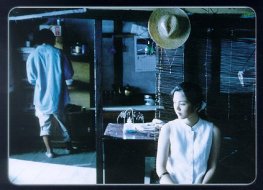 Byeong-rim maintains control of the other two men, giving direction and purpose to responsible, sensitive Chang-do and having to sometimes physically restrain and comfort the more worldly and wild Han-soo. Chang-do adapts well to the conditions in which they find themselves living. He quickly comes to think of the school as a home and the two men with him as his family rather than friends who grew up in the same orphanage as he did. His hobby of sketching helps him pass the time as do the chicks he purchased in one of his car trips into town for supplies. Han-soo (Cheong Jae-wook) has difficulty adjusting to the silence of his new surroundings. He is often drunk and craves the company of women. At one point he goes so far as to conceal himself in the trunk of the car when Chang-do goes to town in the hopes of reaching someplace with more human contact, but he is discovered by Byeong-rim and stopped before he can escape. He hatred for his situation and for what he sees in himself eventually causes him to fall dangerously ill. Byeong-rim is depicted as more practical than Chang-do and with more self-control than Han-soo. He works to get through the days but also knows how to have fun and proves to be able to relate to both of his companions. When the essential work around the schoolhouse is finished, Byeong-rim shows an artistic side of himself and he starts making intricate lanterns using candles, colored bottles and wires. At one point, he finds a necklace with a very distinctive design. He wears it for a while but eventually passes it on to Chang-do.
Byeong-rim maintains control of the other two men, giving direction and purpose to responsible, sensitive Chang-do and having to sometimes physically restrain and comfort the more worldly and wild Han-soo. Chang-do adapts well to the conditions in which they find themselves living. He quickly comes to think of the school as a home and the two men with him as his family rather than friends who grew up in the same orphanage as he did. His hobby of sketching helps him pass the time as do the chicks he purchased in one of his car trips into town for supplies. Han-soo (Cheong Jae-wook) has difficulty adjusting to the silence of his new surroundings. He is often drunk and craves the company of women. At one point he goes so far as to conceal himself in the trunk of the car when Chang-do goes to town in the hopes of reaching someplace with more human contact, but he is discovered by Byeong-rim and stopped before he can escape. He hatred for his situation and for what he sees in himself eventually causes him to fall dangerously ill. Byeong-rim is depicted as more practical than Chang-do and with more self-control than Han-soo. He works to get through the days but also knows how to have fun and proves to be able to relate to both of his companions. When the essential work around the schoolhouse is finished, Byeong-rim shows an artistic side of himself and he starts making intricate lanterns using candles, colored bottles and wires. At one point, he finds a necklace with a very distinctive design. He wears it for a while but eventually passes it on to Chang-do.
The film then shifts to just a few weeks earlier to the end of the rainy season to show how the necklace got there. Three women, former students of the deserted school, make a pilgrimage to their alma mater to lay flowers on the desk of their dead friend. While they sit inside taking refuge from the pouring rain, they girls drink and talk about forgotten dreams and lost friends. Their conversation, clothing style and even umbrella colors mark them as very different characters with a common origin. Ju-kyeong (Im Ji-eun, the older sister in Sympathy for Lady Vengeance) is the counterpart of sensitive Chang-do and she feels an immediate connection with the mountainside school and finds peace on its grounds. Song-yeon (Chang Ga-hyun) simply drinks the entire time she is there, bemoaning her life. Before she passes out in a drunken stupor and placed safely in the car to sleep, she is looked after by Da-jung (Lee Ah-young) who, like Byeong-rim, is a bridge between her two friends.
Because of its small set and cast of just seven people, viewing Fly Low is more like watching a stage play unfolding than a movie. The set, though small, never feels claustrophobic, except perhaps to Han-soo and Song-yeon, and the only intrusion into the seclusion of the place is the subtly comical appearances of an elderly, rural police officer (Choi Jae-pyung) who makes occasional visits to the location -- generally to sleep or drink his lunch. As the story continues, the closeness of the set allows the characters to each find a sense of peace and an understanding of who they are in their own ways.
Fly Low was an independent release produced more for the film festival circuit, opening at festivals in Europe more than six months prior to its release in Korean theaters. Its quiet atmosphere and the non-action of the characters probably prevented it from becoming commercially successful. However, it is an exceptional film that was the first, and so far only, work of director Kim Sion. (Tom Giammarco)
"It's not what you expect," reads the poster displayed on billboards and subway walls. On the other hand, it's probably not too far off.
Yonggary, the Korean Godzilla, crashed into theaters in July 1999, causing a sensation among audiences, who applauded the film's special effects, and film critics, who competed to lend it the sharpest abuse. Financed by Hyundai and the brainchild of comedian Shim Hyung-rae, this feature was rumored to be the most expensive Korean film ever made, at a figure approaching $10 million.
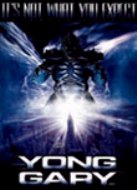 Yonggary is a new kind of animal in the Korean film industry: the B-grade thriller intended for export. Shot in English with a foreign cast, the film's prime targets lie in overseas markets, the United States in particular. And it may well find an audience for its (unintended) charms: campy, sentimental, and utterly ridiculous, this film is good for far more laughs than your average comedy.
Yonggary is a new kind of animal in the Korean film industry: the B-grade thriller intended for export. Shot in English with a foreign cast, the film's prime targets lie in overseas markets, the United States in particular. And it may well find an audience for its (unintended) charms: campy, sentimental, and utterly ridiculous, this film is good for far more laughs than your average comedy.
What makes this film so bad is not so much the cast, chosen from a growing population of Western actors working in Korea (although in truth their acting is quite terrible), but rather the script, which is packed with more tired cliches than I ever knew existed. In the absence of any drama, the film sputters along on the strength of its weirdness, which in my case kept me paying attention for about an hour.
This new movie harkens back to the infinitely cuter Grand Evil Master Yonggary that terrorized audiences in 1967 with shots of a man in a green rubber suit smashing models of buildings and bridges. Alas, the latest version lacks the older film's charm, quirks, and sexual tension, and the '67 monster was a much better dancer.
If you happen to miss Yonggary, fear not. It promises to be only the first in a chain of similar films. Shim's next project? -- Imoogi, the story of a 1000-year old snake. (Darcy Paquet)
By mid-July or so I was becoming frustrated. There had been a number of interesting releases in the first half of the year, but (short of "The Picnic") there was no film that really demanded attention, that one could consider calling a masterpiece. I didn't realize what lay just around the corner.
Nowhere to Hide is an action/art film that simply dazzles. Its style, humor, cinematography, and endless invention combine to make watching it an exhilarating experience.
 Lee Myung-se has made some fascinating films in the past, many of which, such as My Love, My Bride and First Love, have tackled issues of love and marriage. This, his sixth film, draws its inspiration from a more abstract source. "In a Monet painting," Lee says, "the theme is not the water lily. The water lily is just the object to paint light upon. As it floats, we see its reflection on the water, and that is what we call painterly. My intention is the same. In this film, I wanted to show the filmic. The story and the characters are not the main focus of my film. Movement is. Movement enters the other elements in this film to create kinetic action." [quoted from the film's pressbook]
Lee Myung-se has made some fascinating films in the past, many of which, such as My Love, My Bride and First Love, have tackled issues of love and marriage. This, his sixth film, draws its inspiration from a more abstract source. "In a Monet painting," Lee says, "the theme is not the water lily. The water lily is just the object to paint light upon. As it floats, we see its reflection on the water, and that is what we call painterly. My intention is the same. In this film, I wanted to show the filmic. The story and the characters are not the main focus of my film. Movement is. Movement enters the other elements in this film to create kinetic action." [quoted from the film's pressbook]
There are several types of movement which propel this film: the physical movement of the actors (Lee reportedly spent time analyzing the movement in dance and World Cup soccer); the visual movement created by lines of composition within the frame; movement through time (the time for each major scene is faithfully printed for the viewer); movement towards resolution of the plot (a cat-and-mouse chase between a group of cops and a killer); and the movement inherent in Lee's editing, which removes small chunks of the original footage to create a muted, staccato-like propulsion (he makes frequent use of what I guess you would call a "jump-dissolve"). But in contrast to the scattered movement you see in a film such as Wong Kar-Wai's Chungking Express, the movement in this film is directed inward, as it guides us relentlessly to the final confrontation between the pursuer and the pursued.
But to focus on the movement in Nowhere to Hide is to ignore its many other remarkable traits. (1) The humor. I watched this in a packed theater, and the crowd was in uproar; unfortunately much of the humor does not translate well, but the physical humor alone is a delight. (2) The acting. Many of the bruises and cuts you see on the actors' faces are real. Lee insisted on authenticity for this film, and drew forth amazing performances from a very talented group of actors, including Park Joong-hoon, a legendary actor who returns to the spotlight here after an absence of several years; Ahn Sung-ki, adding the role of a ruthless criminal to his long resume; and Jang Dong-gun, a younger actor playing an extremely sympathetic role. Park Joong-hoon's performance draws special note, however, for creating an onscreen image sure to produce teenage imitation in the manner of a Humphrey Bogart or James Dean. (3) The set. This is a gorgeous-looking film, set within steam-filled alleys, gingko-sided streets, and rooftops. The weather shifts without warning between late-afternoon sun, snow, and heavy downpour. Lee also utilizes such cinematically-charged locales as an outdoor stairway and a passenger train.
The only blemish on this film is its remarkably boring English title. A one-word title such as "Ruthless" or "Impulsive" would have better expressed the meaning of the (complex) original title, while perhaps evoking memories of Alfred Hitchcock, who Lee cites as a major influence on his work. Nonetheless, this should in no way detract from what is clearly Lee's best work. (Darcy Paquet)
Sun-woo (Song Seung-hun - Ice Rain, He Was Cool) works in an office that may or may not have something to do with animation. (We know he's an illustrator and the knick-knacks thrown up around the cubes within the office are all animation-oriented, but we never witness Sun-woo actually do any work so I'm just guessing here.) For some time, he's arrived in the morning to find a single calla lily on his desk. A few moments after arriving, he will receive a call where the only noise on the other end is recorded music. He begins to hope these gifts are sent to him from Ji-hee (Kim Hee-sun - Bichunmoo, Wanee and Junah), a woman who works at a flower shop across the way from his work. Initially we follow Sun-woo as his shy, coy self stalks the woman he believes is sending him stalks. With his work sending him to Singapore to do whatever it is he does, he finds the confidence to call her from a pay phone. (One of the interesting sociological aspects of this film is Sun-woo's prominent use of pay phones, causing a dissonant effect for those of
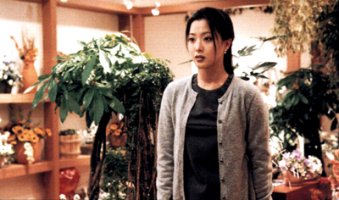 us who have become so used to seeing cell-phones as such necessary attachments to Korean characters in more recent films.) He tells her he loves her even though they've never actually talked outside of a customer/salesperson dyad. However, as unrealistic as this may seem, the woman on the other end of the phone says she loves him too. They promise to meet at a hotel lounge when he returns. Upon his return, he arrives at the hotel to discover a hostage situation, the one presented to us in ghostly slow-mo at the beginning of the film. Sun-woo arrives to witness Ji-hee's death at the hands of a drug dealer, Chung Mi-wook (Choi Cheol-ho - The Quiet Family), who supposedly got high on his own supply. Three years later, still mourning this loss of that which he never had, Sun-woo returns to the lounge to ritualize a goodbye. However, he still cannot let go of her, and while traveling in the elevator downwards, he wishes he could return to the time of the event in order to prevent Jin-hee's death. His wish is the elevator's command because when he reaches the ground floor, he is returned to the year 1995.
us who have become so used to seeing cell-phones as such necessary attachments to Korean characters in more recent films.) He tells her he loves her even though they've never actually talked outside of a customer/salesperson dyad. However, as unrealistic as this may seem, the woman on the other end of the phone says she loves him too. They promise to meet at a hotel lounge when he returns. Upon his return, he arrives at the hotel to discover a hostage situation, the one presented to us in ghostly slow-mo at the beginning of the film. Sun-woo arrives to witness Ji-hee's death at the hands of a drug dealer, Chung Mi-wook (Choi Cheol-ho - The Quiet Family), who supposedly got high on his own supply. Three years later, still mourning this loss of that which he never had, Sun-woo returns to the lounge to ritualize a goodbye. However, he still cannot let go of her, and while traveling in the elevator downwards, he wishes he could return to the time of the event in order to prevent Jin-hee's death. His wish is the elevator's command because when he reaches the ground floor, he is returned to the year 1995.
To tell you more would ruin the twists and turns that Calla takes. (But for those who need to know about all the stars that flicker in this film, Kim Hyun-joo (Shinsuki Blues) plays a character named Su-jin as well.) What results is an interesting take on time travel, that, although I haven't seen enough films or read enough books to know if this is a unique take, veers from a primary assumption about such crossings. Although primarily Sun-woo's story, another person's story enters as well, and it would have been interesting if the basic premise of the story- be careful what you wish for; it might keep you from seeing what you really want - would have cut both ways with both characters, but instead it is only Sun-woo who has something to learn. It is only Sun-woo who has to change. This film shares something with Pisces (Kim Hyung-tae, 2000), another film that plays off the obligatory stalking inherent in too many romantic tales, although they have differing takes on the appropriateness of such tactics.
But that's just me wanting this film to be something other than what it is. What it ends up being is a fairly engaging film with unfortunately too many moments which limit the level of poignancy that director Song Hae-sung accomplished in Failan. Plot problems arise such as why Sun-woo would not have the gun he stole taken away from him when he was hospitalized. One would think the emergency room attendants would find his possession of such outlawed weapons worthy of concern. But he still has this gun at the ready to wield later when needed. There are more problems than just plot points. The exaggerated scowl of drug dealer Chung when Sun-woo confronts him later in the film is so over-done as to appear almost campy, which is surely not the effect director Song intended. And the need to repeat so much through internal flashbacks to scenes prior, although understandable in that Song intends to give the flipside of the story, ends up tying loose ends at the expense of having the film stay with me long after viewing it. Rather than having the film meander in my mind, re-reading previous scenes with the new information of later scenes, Song leaves nothing to chance, telling me what to think, causing the film to finish rather than float with me in the future. He could have hinted more and completely diagrammed less. This film had potential that failed to deliver. But that's ok considering how well the one telling of two tales fell into place with Song's next attempt, Failan. (Adam Hartzell)
Four young thugs are bored one night, so they decide to rob a gas station, just for fun. When they find it has no money, they lock the employees up and stay there for the night, pumping gas. Once they get the hang of the equipment, the money starts to flow, and if customers give them any problems, they just take them hostage.
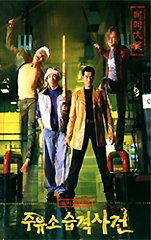 This comedy by Kim Sang-jin has taken Korea completely by surprise. Before it opened, it generated little interest, with no truly big-name stars and a director whose last movie, Two Cops 3, was considered a disappointment. Once it started playing in theaters, however, word of mouth together with a strong marketing campaign eventually turned this film into the hottest feature of the month.
This comedy by Kim Sang-jin has taken Korea completely by surprise. Before it opened, it generated little interest, with no truly big-name stars and a director whose last movie, Two Cops 3, was considered a disappointment. Once it started playing in theaters, however, word of mouth together with a strong marketing campaign eventually turned this film into the hottest feature of the month.
Attack the Gas Station derives its humor from a combination of slapstick violence and a tangled, shifting system of power relations. Most everyone in the film is nursing an ego, small or large, and the viewer's pleasure lies in watching them all slug it out, in a desperate attempt to avoid looking weak or ridiculous. However, it is when the characters do fail and expose their weaknesses that we begin to feel empathy for them.
The film features two up-and-coming actors in Lee Sung-jae (Art Museum by the Zoo) and Yoo Oh-sung (The Spy). Both actors are convincing as the young lawbreakers who eventually come to represent moral order and decency in the small corner of society that develops at the gas station.
This movie does perhaps have a hint of social criticism, with its digs at Korean high school and the local police force, but at its heart it delights in simple, throwaway humor where overreacting becomes the norm and Chinese takeout becomes a matter of life and death. (Darcy Paquet)
In the summer of 1999, a series of black garbage bags filled with dismembered body parts (one part missing from each bag) begin to show up around Seoul: in an elevator, on a highway, at the edge of a basketball court. Detective Cho, assigned to the case, struggles to identitify the victims. When at last the killer starts to drop hints, Cho makes a startling discovery: all the victims are ex-lovers of a woman named Su-yeon, a curator at the National Museum. In the course of his inquiry, Cho befriends Su-yeon, and begins to learn about her troubled past.
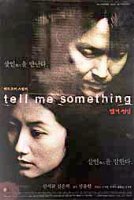 This film opened as one of the most anticipated releases in Korean film history. Aside from memories of director Chang Yoon-hyun's 1997 debut film (The Contact) and the star power provided by Han Suk-kyu and Shim Eun-ha, the movie benefitted from an amazing marketing campaign. 1999 marks the first year that Korean production companies have devoted their energies to advertising, with three films in particular -- Shiri, Nowhere to Hide and Attack on the Gas Station -- allocating a significant portion of their budget to marketing. With stylish black-and-white posters and an explosive trailer, Tell Me Something had moviegoers salivating weeks ahead of its release.
This film opened as one of the most anticipated releases in Korean film history. Aside from memories of director Chang Yoon-hyun's 1997 debut film (The Contact) and the star power provided by Han Suk-kyu and Shim Eun-ha, the movie benefitted from an amazing marketing campaign. 1999 marks the first year that Korean production companies have devoted their energies to advertising, with three films in particular -- Shiri, Nowhere to Hide and Attack on the Gas Station -- allocating a significant portion of their budget to marketing. With stylish black-and-white posters and an explosive trailer, Tell Me Something had moviegoers salivating weeks ahead of its release.
Perhaps in part to these soaring expectations, the finished product was met with some disappointment, with clever viewers dubbing the film "Tell Me Nothing." Criticism focused mostly on the storyline, which was felt to lack excitement. Part of this can be blamed on its packaging: the movie calls itself a "hard-gore thriller," when in fact its genre is more complex. At times introspective, at times losing itself in its dark scenery, the film is better described as a slow mystery, strewn with eruptions of gore.
Visually, the film is very interesting. More than any other Korean director, Chang Yoon-hyun knows how to capture the moods and look of the city. I attribute much of the success of Chang's first film to its urban feel and sensibility; in Tell Me Something, he further enriches his palette to create images of the city that at times resemble painting. Chang also plays off the star image of Shim Eun-ha in a wonderful scene in the killer's workshop, where her face is reflected on a series of photographs resembling a video wall. For those that remember the gut-wrenching car accident in The Contact, this newer film features another, beautifully-choreographed crash. And finally, one cannot overlook the imagery of the victims' bodies, dismembered and arranged on tables in horrifying geometrical designs.
Although in some ways this film has fallen victim to its own hype, it has drawn a tremendous number of viewers and provides a fascinating addition to this year's crop of films. (Darcy Paquet)
When the making of this film was first announced, most assumed it would be fairly conventional, the story of an extramarital affair. As it neared release, however, it became apparent that the film would have teeth, and it has emerged as one of the strongest art films of the past several years.
 Happy End is the debut work of director Jung Ji-woo, who won acclaim with an earlier short film titled A Bit Bitter (literal translation: "Ginger"). This new work focuses on three characters: a banker who loses his job but finds a sense of fulfillment in his new life at home, taking care of his daughter and reading mysteries in the park; his wife, a successful career woman who manages a language institute; and her ex-boyfriend, with whom she became separated years earlier when he was drafted into the army.
Happy End is the debut work of director Jung Ji-woo, who won acclaim with an earlier short film titled A Bit Bitter (literal translation: "Ginger"). This new work focuses on three characters: a banker who loses his job but finds a sense of fulfillment in his new life at home, taking care of his daughter and reading mysteries in the park; his wife, a successful career woman who manages a language institute; and her ex-boyfriend, with whom she became separated years earlier when he was drafted into the army.
Happy End marks the maturation of a new generation of filmmakers who began their careers in short film. Although Jung is obviously not the first director to follow up a successful career in short film with an acclaimed debut (other notable examples include E J-Yong with An Affair, Park Ki-hyung with Whispering Corridors, and Hur Jin-ho with Christmas in August), he is nonetheless the first to infuse a full-length feature with the aesthetics and vitality of Korean short film. The tight form and emotional intensity of Happy End, together with the ambiguous manner of its resolution, give audiences a more concentrated viewing experience than most feature films.
The acting in this movie deserves special mention, with two of Korea's most talented actors giving virtuoso performances. Following up his popular success in the movie Shiri, Choi Min-shik takes on a hugely difficult role as the husband who discovers his wife's infidelity. In addition to the emotional range required by the part, it is also clear that the situation faced by the husband carries a symbolic weight in the film. Choi's haunted, suffering eyes bring forth an tremendous empathy in the viewer. Opposite him, actress Jeon Do-yeon shatters her earlier screen image with a daring, mesmerizing performance that sets her on a level apart from other actresses of her generation.
Happy End pulls no punches in its delivery, straining its viewers' emotions as well as pushing the limits of the film's form. In its art and its impact, it is an unforgettable film. (Darcy Paquet)
December proved to be full of surprises: first the critical and popular success of Happy End, and then the showstopper: a teenage girls' horror flick that has to rank as the most inventive and eerily beautiful film of the year.
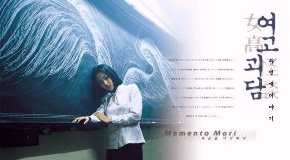 This so-called sequel to the 1998 film Whispering Corridors actually has very little in common with it, employing different directors, a different cast, and a completely different storyline, locale, and aesthetic. The screenplay borrows from the original work only the general notion of a student haunting a school, making for a film with a very different focus. It is directed and written by Kim Tae-yong and Min Kyu-dong, two men who collaborated on several short films and are now making their feature debut. For actors they use three teenage models who give intense, compelling performances in their first cinematic roles: Lee Young-jin, Park Eh-Jin, and Kim Min-sun.
This so-called sequel to the 1998 film Whispering Corridors actually has very little in common with it, employing different directors, a different cast, and a completely different storyline, locale, and aesthetic. The screenplay borrows from the original work only the general notion of a student haunting a school, making for a film with a very different focus. It is directed and written by Kim Tae-yong and Min Kyu-dong, two men who collaborated on several short films and are now making their feature debut. For actors they use three teenage models who give intense, compelling performances in their first cinematic roles: Lee Young-jin, Park Eh-Jin, and Kim Min-sun.
Memento Mori (from Latin, translated as "remember that you must die") revolves around three students at an all-girls' high school. When Min-ah finds a diary, she gains a glimpse into the relationship between two ostracized students named Hyo-shin and Shi-eun. As the film progresses we witness Hyo-shin's suicide and descend into a vortex of flashbacks, revelations, and supernatural vengeance. In the original screenplay the relationship between Hyo-shin and Shi-eun contained very strong lesbian overtones; some of this was toned down in the course of production and then several scenes were cut by the ratings board just before release in order to receive a 12+ rating. Nonetheless the nature of their relationship remains clear and central to the film.
This is not your typical horror movie. With its splintered narrative and hardly a drop of blood, the film lingers instead on the dynamics of the classroom and the intensity of its young heroines. The forces that govern the film seem to care very little about the ultimate fate of its characters, preferring instead to ruminate on the past. Eventually we realize that these filmed episodes at the high school do not make up a story; they are more of a memento. And for a film that so completely reinvents its genre, perhaps we can best learn what to expect from it by opening our dictionary:
memento. (1) either of two prayers in the Canon of the Mass, one for the living and one for the dead, beginning "Memento;" (2) anything serving as a reminder or warning; (3) a souvenir. (Darcy Paquet)
Other films released in 1999
L'Amour (dir. Lee Du-yong), The Bird Who Stops in the Air (dir. Jeon Soo-il), Black Hole (dir. Kim Kuk-hyung), Black Honeymoon (dir. Na Hong-kyun), The Cut Runs Deep (dir. John H. Lee), Dance Dance (dir. Moon Seong-wook), Dr. K (dir. Kwak Kyung-taek), Fin de Siecle (dir. Song Neung-han), Fly Low (dir. Kim Sion), Ghost in Love (dir. Lee Kwang-hoon), The Great Chef (dir. Kim Ui-seok), Love (dir. Lee Jang-soo), Mayonnaise (dir. Yoon In-ho), My Heart (dir. Bae Chang-ho), Mystery of the Cube (dir. Jonathan You), The Opening (dir. Kim Sung-hong), Our Sunny Days (dir. Kim Sung-soo), Phantom, the Submarine (dir. Min Byung-chun), Rainbow Trout (dir. Park Chong-won), Rush (dir. Lee Sang-in), A Sudden Crash of Thunder (dir. Lee Ji-sang), The Uprising (dir. Park Kwang-su), White Valentine (dir. Yang Yoon-ho).














